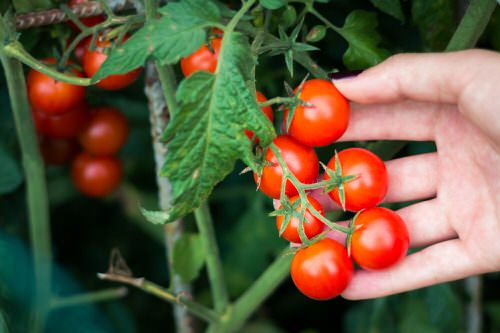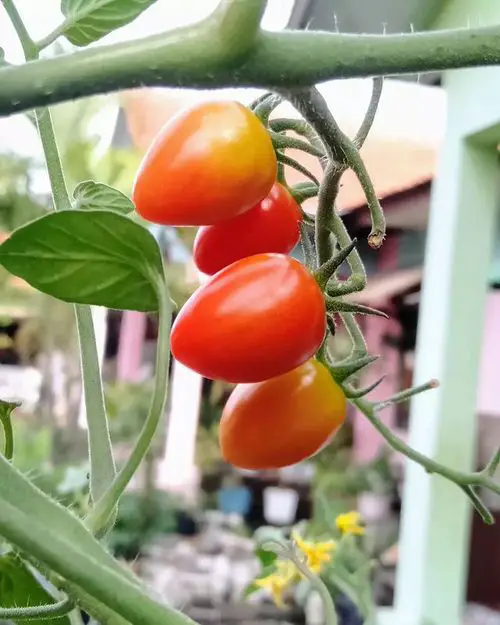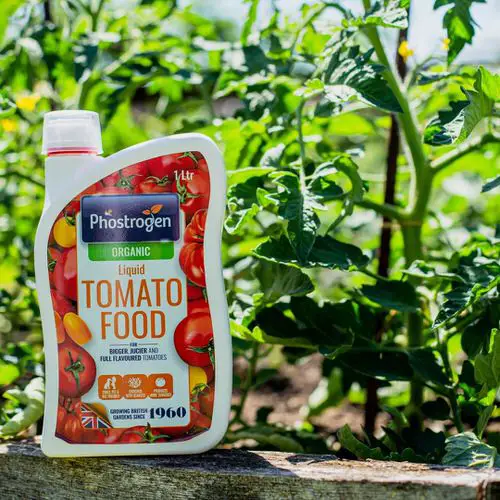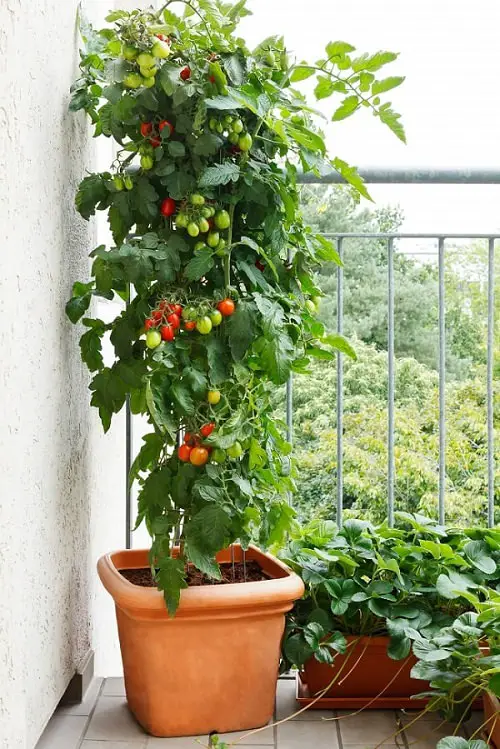Want to Grow so Many Tomatoes in so Little Space? We have the best tricks to help you harvest the juiciest tomatoes more!

Discover the 9 best things that increase tomato harvest even in a limited space like never before to enjoy a fresh bumper 😄 harvest even if you don’t have a garden!
Learn how to grow tomatoes from suckers here
How to Grow so Many Tomatoes in so Little Space!
1. Mind the Time
Don’t start the plants too early before the season unless you live in a warm climate. Otherwise, your tomato plants will be exposed to unexpected late frost and cold temperatures.
The best planting time is when the temperature starts to stay above 50 F (10 C). Also, provide the sunlight, as much sun as possible. The logic is simple–the more your tomato plant will soak the sunlight, the sooner it will establish and start fruiting.
2. Plant them Very Deeply
Unlike all other plants, tomatoes must be planted deeply. Deep planting encourages a healthy and strong root system.
Some growers recommend burying 1/3 of the seedling, but we suggest covering the bottom 2/3 part of your tomato seedling with potting soil. This provides a significant chance for root development and superb harvest later.
For example, if your tomato transplant is 10 inches high, leave only 3 or 4 inches of its height from the top. While doing this, don’t forget to remove the lower leaves and lateral stems.
3. Pick the Right Variety

Grow determinate varieties of tomatoes if you’re short of space or growing tomatoes in containers. Determinate tomatoes don’t grow too tall or wide (generally, 3 to 4 feet).
Both hybrid and heirloom cultivars are available in it!
Growing indeterminate tomatoes in a small space can be a mistake, most of the cultivars can easily grow above 5 to 6 feet tall and spread a lot, thus require strong support by caging or staking.
On the other hand, the determinate type of tomatoes requires slight support. However, if you have space, grow indeterminate ones for productivity!
Here are the best types of Roma Tomatoes
4. Provide Space

Space your tomato plants well, 14-18 inches apart. Ideally, you should leave the space of 24 inches if possible. Tomato plants grown too close are prone to fungal diseases and are less productive.
On a small balcony, you can even grow smaller varieties more closely. Consider cherry tomatoes. But remember, tomatoes growing too tightly require more attention: More fertilizer, water, and pruning.
5. To Prune or Not to Prune
Pruning is not necessary for determinate tomatoes unless plants are grown too close. But if you have indeterminate ones, always do this regularly and prune tangling branches that are blocking the airflow and penetration of the sun.
Also, remove suckers (emerging stems) up to 6-8 inches under each plant. This will improve the productivity of the plant. You can also propagate suckers to grow new plants!
Do not miss these pro tips on pruning tomatoes rightly
6. Pot Selection is the Key

Use large pots or grow bags to grow tomatoes. You can also house them in a 5 to 7 gallon pot that is 14 inches deep for a single plant of determinate variety.
For an indeterminate type, choose a bigger container. The container should be deep; a minimum of 14-16 inches is necessary.
7. Water the Plants in a Correct Manner
When growing tomatoes in a container, regular watering is essential. Watering must be done in the morning. Almost every day or two in summer. In the hot climate, you may even need to water twice a day.
Avoid overhead watering! Wetting the foliage is a bad practice as wet leaves and stems are more prone to diseases.
Learn how to grow tomatoes from slices here
8. Feed the Plants

The deficiency of calcium promotes blossom end rot in tomatoes. It is an essential element in the uptake of nutrients. Calcium also saves the plant from heat stress and affects fruit quality.
At the time of planting, place 2-3 crushed chicken eggshells in the bottom. This will provide a constant supply of minerals and calcium to the plant.
Sprinkle some bonemeal at the time of planting, especially if your soil lacks calcium, you can also add handful of it again during the mid growth.
Bonemeal will also provide a slow and steady supply of phosphorus to the plant. It is an organic product that consists of a higher amount of phosphorus and calcium.
Check out the best homemade fertilizers for tomatoes here
9. Grow them Vertically

You can easily train the tomatoes to grow vertically, which is the best method to enjoy a fresh harvest in a limited space. For this, you’ll have to use a trellis or a support system.
Our editor found Sungold, Blondkopfchen, Black Cherry, and Gardeners Delight the best for vertical growing.
Similarly, you can also grow them in hanging baskets to save space. Grow Tiny Tim, Red Robin, Celano Hybrid, and Whippersnapper for plenty of harvest.
Some Quick Tips to Grow the Best Tomatoes

- Caging needs more space, so instead of it–support tomatoes by stacking. If you are growing tomatoes on a balcony, consider tying them up to the railing.
- Don’t grow tomatoes upside down. It is a fancy idea but not a practical one. However, you can grow tomatoes (cherry tomatoes) in hanging baskets.
- Use a soilless potting mix for a better result. You can buy it or make your own following the recipes here.
- Soil pH matters! The ideal pH for tomatoes is around 6 – 6.8. Slightly acidic to a bit neutral!
- Add worm castings, well-rotted manure, or vermicompost to the soil to enrich it. You can also throw worms in the soil.
- Use bonemeal and Epsom salt for tomatoes. To know why and how–check out our article.
- Once a month, fertilize the plant with liquid seaweed, compost, or manure tea.
- Mulch your tomato plants; it is essential. For mulching, use organic matter, crushed eggshells, coffee grounds, or used tea leaves.
- Keep an eye on diseases and pest problems and solve them as soon as they emerge, keep an eye on spider mites and leaf miners.



Great article! Another way to grow a lot of tomatoes in a small amount of space is via aquaponics!
Use full information
Good post. I am bookmarking this for my vegetable garden this year!
A lot of useful ideas. Learned a lot. Will try to apply them to improve my second year balcony garden.
Really nice article.I have seen here many information that will help the people.But I like aquaponics to grow tomato.
Using good potting soil is very important. Great information.
My parents getting soil from forrest .
That’s the best soil ever !
You can cordon grow indeterminate tomatoes spacing them as close as 12-18 inches. I get far more tomatoes cordon growing indeterminate tomatoes vs letting determinate tomatoes sprawl. Cordon growing requires pruning and staking but it keeps the fruit clean, keeps the air moving and looks clean and tidy in the garden. It also produces larger fruit, and I find they ripen faster. In prior years where I let my vines sprawl and I struggled to find ways to keep them off the ground I had nothing but issues – it’s worth the effort to cordon grow, well it’s worth the effort for me because I have limited space and LOVE my heirloom tomatoes.
Can u explain cordon growing ? And would it help in a tiny garden plot?
https://www.gardenersworld.com/how-to/grow-plants/how-to-grow-cordon-tomatoes/
This is quite interesting. Where can one get the seeds. it got me fascinating. can these specie grow in tropical climate?
Good idea I liked it very much . I will try this type.
I find this very informative and must try it this year,Will let you know how they grow this year. Thanks.
Good and useful information. How and where can I get the tomatoes seed especially the determinate tomatoes seeds. Please can you explain the preferred time to plant in the tomatoes in the tropics.
Thank you.
How and where can I get the seeds?
The article sounds so easy that I think I can do this.
Thank you
This is everything I needed to venture into planting
Interesting ideas to grow tomatoes. Has been a challenge recently. Will try growing in pots with trellis.